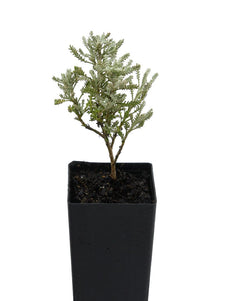
Santolina Grey
Santolina Grey

- In stock, ready to ship
- Inventory on the way

Usually available: All year
Life cycle: Perennial
Height: 30 - 50cm
Position: Full sun
Soil preference: Well drained
This is how we pack and send your Herb Plants to all states except TAS & WA
You will receive
- 1 Santolina Grey Herb Plant in a 50 X 75mm tube - General growing instructions
All of our Herb Plants are grown organically with certified organic potting mixes and fertilizers
Botanical Name: Santolina chamaecyparissus
Santolina chamaecypraissus, or Santolina Grey, is a small, evergreen shrub growing from 10-50cm high by 50cm to 1 meter wide after 5-10 years. It is densely covered in narrow, entire or pinnate grey-green leaves that cover the stems or branches. These attractive and aromatic leaves create the appearance of a cross between lavender and the pine cypress foliage. At a distance the small branches look a little like fern fronds. When crushed the leaves have a pungent, but pleasant aroma. The yellow button-like flower heads appear on two year old branches in summer. They are 2cm in size, composite flowers and are held aloft on slender stems above the foliage.
Santolina Grey is found within the Asteraceae family and has the botanical name Santolina chamaecyparissus. The species designation means ‘like cypress’ and refers to the resemblance of the leaves to the cypress family of plants. This plant is also known by other common names including Cotton Lavender, Lavender Cotton, Ground Cypress, Grey Cotton and French Lavender with the references to lavender being due to both the colour and the aromatic leaves. Santolina Grey is not closely related to either lavender or cypress. S. chamaecyparissus was previously named Santolina incana and is also sometimes identified by the scientific synonym Chamaecyparissus africanus.
The native habitat of Santolina Grey is the Western and Central Mediterranean regions, with naturalization occurring in suitable climatic regions of Britain, Europe and North America. In the native environment it prefers to grow in dry, stony and rocky banks, where the soil is mostly calcereous and nutritionally poor. These regions are very warm and dry, and usually arid, coastal or mountainous regions. Plants like Santolina Grey and Santolina Green do well in warm areas due to their ability to minimize evaporation by having tough, thin or narrow leaves. This plant is also a valuable food source for some Lepidoptera species in its wild state.
This decorative grey plant does have a history of medicinal use. Today it is mostly grown for its ornamental value and is a great companion for roses or hedged to form borders. It is known for its great value in hot, dry regions so will do well in most Australian gardens. There are a number of cultivars that have been developed for home gardens.
Growing Conditions
Santolina Grey prefers full sun and a dry, warm position. It does not do well in shade or with wet, humid and damp conditions. Overwatering will kill this plant. It prefers poor soil, which is sandy to medium loam, and well drained. This plant will do well in chalky, calcium rich soils and is wind tolerant, so maritime exposure is acceptable. Santolina Grey does not need rich soils. Once established it will be drought tolerant and also tolerates frost and cold temperatures to -15C. This is a hardy and easy to grow plant that may be hedged and pruned regularly to keep its shape. Flowers grow on two year old wood. Since they are quite small, the flowers are often prevented from growing by shearing the plant to create a hedging effect. This plant is very hardy, but may tend to be short lived. Propagation may be via seed, semi-hardwood cuttings and division in spring and summer.
Culinary Uses
Santolina Grey has aromatic leaves that may be used for flavouring soups, broths, stews, sauces, meat and fish or grain dishes. It should be used sparingly so taste is not too strong. The leaves and flowers may be harvested in summer and dried for later use.
Medicinal Uses
In earlier times, Santolina Grey was used for medicinal purposes by herbal medicine practitioners. The leaves and flowers were considered to be antispasmodic, disinfectant, stimulant, vermifuge and to assist with regulating menstrual cycles. They were also crushed and used to treat insect bites and stings, relieving pain very quickly. When applied to the surface of wounds this plant would help them to heal.
Santolina Grey has many active constituent chemicals which have been shown to be useful. However the scientific research is inconclusive in regard to how effective they really are for their intended use. The concentration of chemicals within plants is often variable depending on circumstances such as amount of sun, nutrients, season, growth cycle and age of the plant. It is therefore difficult to isolate how much of any particular herb would be a useful home remedy. Santolina is rarely used as an herbal remedy today, with the main reason for growing this plant being ornamental.
However, it is worth noting that for some people the crushed leaves may cause a rash or allergic reaction.
Other Uses
Santolina Grey may be used as an herbal tobacco substitute and when hung in wardrobes it makes a useful moth repellent. It can also be used as pot pourii and for making dried wreaths. Essential oils are made from the flowers and leaves and used in perfumery.
All information provided on this website is for informational purposes only. Please seek professional advice before commencing any treatment.




